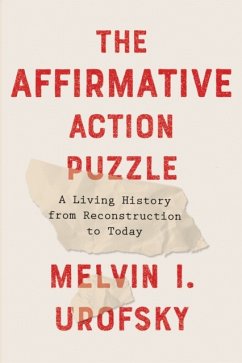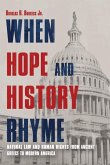Chapter 1: AFFIRMATIVE ACTION BEFORE KENNEDY
Studies of affirmative action often begin with either John F. Kennedy&rsquo s Executive Order 10925 or the more important one by Lyndon Johnson a few years later. However, some forms of affirmative action&mdash programs that would open opportunity or provide benefits for groups hitherto excluded&mdash go back to Reconstruction following the Civil War. The phrase itself, though, was never used to describe these programs, nor did there exist a coherent set of governmental policies designed to attack racism and economic discrimination.
In the Civil Rights Act of 1866, Congress declared that &ldquo all persons within the jurisdiction of the United States shall have the same rights in every State and Territory, to make and enforce contracts, to sue, be parties, give evidence, and to the full equal benefit of all laws and proceedings for the security of persons and property as is enjoyed by white citizens.&rdquo The law also empowered the president to use the national armed forces, if necessary, to implement these provisions and made it a federal crime to interfere with a person&rsquo s exercise of civil rights.
President Andrew Johnson had no intention of using these powers, and in fact vetoed the bill, characterizing it as illegal because it contained &ldquo a distinction of race . . . made to operate in favor of the colored and against the white race.&rdquo Johnson also attacked the measure as race legislation that would encourage a life of wasteful laziness for southern blacks. Johnson&rsquo s veto message is worth examining, because in it one can hear the same arguments against affirmative action that will be common a century later.
Johnson disliked the citizenship provision, because it immediately made citizens of former slaves while European immigrants had to wait several years to qualify through naturalization. This &ldquo proposed a discrimination against large numbers of intelligent, worthy and patriotic foreigners in favor of the negro.&rdquo He opposed federal enforcement of the rights given the freedmen, because it affords &ldquo discriminatory protection to colored persons.&rdquo These arrangements &ldquo established for the security of the colored race safeguards which go infinitely beyond any that the General Government has ever provided for the white race. In fact, the distinction of race and color is by the bill made to operate in favor of the colored and against the white race.&rdquo In response, Congress passed the measure over Johnson&rsquo s veto. Unfortunately, no president in the rest of the nineteenth century used any of these powers, nor did any of them try to enforce the rights embedded in the Fourteenth and Fifteenth Amendments to the Constitution. Congress passed additional civil rights legislation in 1870, 1872, and 1875 and utilized the occupation army as well as the Freedmen&rsquo s Bureau to try to give former slaves access not only to political rights but to economic opportunities as well.
As Congress took steps to provide the former slaves with oppor tunities previously denied to them, we also see the first indications of what will later be called &ldquo white backlash&rdquo and &ldquo reverse discrimina tion.&rdquo A Florida slaveholder fumed that those who abolished slavery wanted to &ldquo give the nigger more privileges than the white man.&rdquo In 1874, the Chicago Tribune ran an editorial in opposition to proposed federal legislation prohibiting racial discrimination in public accom modations. Titled &ldquo The Nigger School?,&rdquo the editorial asked, &ldquo Is it not time for the colored race to stop playing baby?&rdquo Justice Joseph Bradley in the Civil Rights Cases accused blacks of seeking preferential treatment by demanding the end of caste-like exclusions. &ldquo When a man has emerged from slavery,&rdquo he lectured, &ldquo there must be some stage in the progress of his elevation when he takes the rank of a mere citizen and ceases to be the special favorite of the law.&rdquo
Opposition from whites also greeted the proposed Fifteenth Amendment, which gave blacks the right to vote, and this opposition came not only from the South. Senator James Doolittle of Wisconsin argued that if the former slaves could vote, they could be voted for, and &ldquo if they can be voted for, they can be elected members of the legislature, . . . members of the Senate of the United States generals in your army and . . . they might perhaps in the end elect some Negro as President of the United States.&rdquo
In addition to constitutional amendments and civil rights stat utes, Congress established the Bureau of Refugees, Freedmen, and Abandoned Lands, commonly called the Freedmen&rsquo s Bureau. At its beginning, the agency helped both newly freed slaves and white war refugees with housing, employment, food, legal advice, and educa tion, things that could easily be seen as part of a more modern general welfare program. The original charter ran only one year, but by the time it came up for renewal in 1866, its sole clientele were African Americans, and one scholar claims that its activities &ldquo most prefigured the race conscious remedies enacted in the 1960s and after.&rdquo The bureau continued to operate under the aegis of the U.S. Army. Its task became harder as southern opposition increased, and it finally went out of business in 1872.
Frederick Douglass, the runaway slave who became an abolitionist leader, is often cited for the proposition that Negroes did not want any special treatment. In lectures to white audiences, he would ask them to let blacks sink or swim on their own and say that character, not color, was all that mattered. &ldquo Do nothing with us,&rdquo he declared, &ldquo and if the Negro cannot stand on his own legs, let him fall also.&rdquo But at the same time, he argued that before the black man could be judged on his own merits, the handicaps of years of slavery, little or no education, and lack of experience in self-government had to be erased. Special federal legislation for safeguarding the rights of the freedmen had to be maintained until they were no longer needed. &ldquo We certainly hope that the time will come when the colored man in America shall cease to require special attention,&rdquo Douglass declared. &ldquo But that time has not yet come, and is not even at the door.&rdquo
Nor would it be in his lifetime, or in those of his children. In 1883, the Supreme Court severely limited congressional power to protect the former slaves, and thirteen years later approved racial segregation under the rubric of separate but equal in Plessy v. Ferguson. By then, however, the abolitionists and their desire to see justice as well as freedom for the former slaves had passed from the scene. Whites in the North, while they opposed slavery, did not believe African Americans were their social or intellectual equals, and were perfectly happy to let the southern states work out whatever system of racial relations they wanted. Where there had been some protest against the Court&rsquo s civil rights decision in 1883, there was scarcely a peep outside black-owned newspapers following Plessy. Race relations played no part in the nation&rsquo s policy-making dialogue for the next forty years, until the Great Depression.
Hinweis: Dieser Artikel kann nur an eine deutsche Lieferadresse ausgeliefert werden.
Studies of affirmative action often begin with either John F. Kennedy&rsquo s Executive Order 10925 or the more important one by Lyndon Johnson a few years later. However, some forms of affirmative action&mdash programs that would open opportunity or provide benefits for groups hitherto excluded&mdash go back to Reconstruction following the Civil War. The phrase itself, though, was never used to describe these programs, nor did there exist a coherent set of governmental policies designed to attack racism and economic discrimination.
In the Civil Rights Act of 1866, Congress declared that &ldquo all persons within the jurisdiction of the United States shall have the same rights in every State and Territory, to make and enforce contracts, to sue, be parties, give evidence, and to the full equal benefit of all laws and proceedings for the security of persons and property as is enjoyed by white citizens.&rdquo The law also empowered the president to use the national armed forces, if necessary, to implement these provisions and made it a federal crime to interfere with a person&rsquo s exercise of civil rights.
President Andrew Johnson had no intention of using these powers, and in fact vetoed the bill, characterizing it as illegal because it contained &ldquo a distinction of race . . . made to operate in favor of the colored and against the white race.&rdquo Johnson also attacked the measure as race legislation that would encourage a life of wasteful laziness for southern blacks. Johnson&rsquo s veto message is worth examining, because in it one can hear the same arguments against affirmative action that will be common a century later.
Johnson disliked the citizenship provision, because it immediately made citizens of former slaves while European immigrants had to wait several years to qualify through naturalization. This &ldquo proposed a discrimination against large numbers of intelligent, worthy and patriotic foreigners in favor of the negro.&rdquo He opposed federal enforcement of the rights given the freedmen, because it affords &ldquo discriminatory protection to colored persons.&rdquo These arrangements &ldquo established for the security of the colored race safeguards which go infinitely beyond any that the General Government has ever provided for the white race. In fact, the distinction of race and color is by the bill made to operate in favor of the colored and against the white race.&rdquo In response, Congress passed the measure over Johnson&rsquo s veto. Unfortunately, no president in the rest of the nineteenth century used any of these powers, nor did any of them try to enforce the rights embedded in the Fourteenth and Fifteenth Amendments to the Constitution. Congress passed additional civil rights legislation in 1870, 1872, and 1875 and utilized the occupation army as well as the Freedmen&rsquo s Bureau to try to give former slaves access not only to political rights but to economic opportunities as well.
As Congress took steps to provide the former slaves with oppor tunities previously denied to them, we also see the first indications of what will later be called &ldquo white backlash&rdquo and &ldquo reverse discrimina tion.&rdquo A Florida slaveholder fumed that those who abolished slavery wanted to &ldquo give the nigger more privileges than the white man.&rdquo In 1874, the Chicago Tribune ran an editorial in opposition to proposed federal legislation prohibiting racial discrimination in public accom modations. Titled &ldquo The Nigger School?,&rdquo the editorial asked, &ldquo Is it not time for the colored race to stop playing baby?&rdquo Justice Joseph Bradley in the Civil Rights Cases accused blacks of seeking preferential treatment by demanding the end of caste-like exclusions. &ldquo When a man has emerged from slavery,&rdquo he lectured, &ldquo there must be some stage in the progress of his elevation when he takes the rank of a mere citizen and ceases to be the special favorite of the law.&rdquo
Opposition from whites also greeted the proposed Fifteenth Amendment, which gave blacks the right to vote, and this opposition came not only from the South. Senator James Doolittle of Wisconsin argued that if the former slaves could vote, they could be voted for, and &ldquo if they can be voted for, they can be elected members of the legislature, . . . members of the Senate of the United States generals in your army and . . . they might perhaps in the end elect some Negro as President of the United States.&rdquo
In addition to constitutional amendments and civil rights stat utes, Congress established the Bureau of Refugees, Freedmen, and Abandoned Lands, commonly called the Freedmen&rsquo s Bureau. At its beginning, the agency helped both newly freed slaves and white war refugees with housing, employment, food, legal advice, and educa tion, things that could easily be seen as part of a more modern general welfare program. The original charter ran only one year, but by the time it came up for renewal in 1866, its sole clientele were African Americans, and one scholar claims that its activities &ldquo most prefigured the race conscious remedies enacted in the 1960s and after.&rdquo The bureau continued to operate under the aegis of the U.S. Army. Its task became harder as southern opposition increased, and it finally went out of business in 1872.
Frederick Douglass, the runaway slave who became an abolitionist leader, is often cited for the proposition that Negroes did not want any special treatment. In lectures to white audiences, he would ask them to let blacks sink or swim on their own and say that character, not color, was all that mattered. &ldquo Do nothing with us,&rdquo he declared, &ldquo and if the Negro cannot stand on his own legs, let him fall also.&rdquo But at the same time, he argued that before the black man could be judged on his own merits, the handicaps of years of slavery, little or no education, and lack of experience in self-government had to be erased. Special federal legislation for safeguarding the rights of the freedmen had to be maintained until they were no longer needed. &ldquo We certainly hope that the time will come when the colored man in America shall cease to require special attention,&rdquo Douglass declared. &ldquo But that time has not yet come, and is not even at the door.&rdquo
Nor would it be in his lifetime, or in those of his children. In 1883, the Supreme Court severely limited congressional power to protect the former slaves, and thirteen years later approved racial segregation under the rubric of separate but equal in Plessy v. Ferguson. By then, however, the abolitionists and their desire to see justice as well as freedom for the former slaves had passed from the scene. Whites in the North, while they opposed slavery, did not believe African Americans were their social or intellectual equals, and were perfectly happy to let the southern states work out whatever system of racial relations they wanted. Where there had been some protest against the Court&rsquo s civil rights decision in 1883, there was scarcely a peep outside black-owned newspapers following Plessy. Race relations played no part in the nation&rsquo s policy-making dialogue for the next forty years, until the Great Depression.
Hinweis: Dieser Artikel kann nur an eine deutsche Lieferadresse ausgeliefert werden.







![The Trumpet of Conscience [With CD (Audio)] The Trumpet of Conscience [With CD (Audio)]](https://bilder.buecher.de/produkte/30/30884/30884912m.jpg)